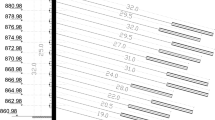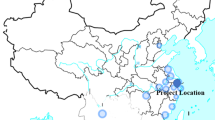Abstract
A case study of Tangluo Street of the Nanjing Metro is considered to understand the modulus evolution with strain to serve the deep excavation design in the city center for sensitive environment control. Laboratory tests were conducted on soft clay sample from the Yangtze river floodplain to determine the parameters of the hardening soil model with small-strain stiffness (HSS model), and back analyzed using the finite element method. The key parameters of HSS model were determined: the reference tangent modulus, reference secant modulus, reference loading, and unloading modulus and reference initial modulus were 3.4, 1.8, 47.7, and 54.2 MPa, respectively. The simulation suggests that the displacement distribution by the HSS model agrees well with the field measurements. On back-analyzing using the Mohr–Coulomb model with a modulus four to five times the oedometer modulus, the calculated deformation was close to that obtained from simulation using the hardening soil model with small-strain stiffness (HSS model), and in situ observed displacement. This degree of amplification also reflects the deformation-controlling requirement of retaining structures and should be mobilized with changes in the requirement.









Similar content being viewed by others
Data Availability
The data used to support the findings of this study are available from the corresponding author upon request.
References
Qiu DH, Liu Y, Xue YG, Su MX, Zhao Y, Cui JH, Kong FM, Li ZQ (2021) Prediction of the surrounding rock deformation grade for a high-speed railway tunnel based on rough set theory and a cloud model. Iran J Sci Technol Trans Civil Eng 45(1):303–314. https://doi.org/10.1007/s40996-020-00486-7
Yang F, Cao SR, Qin G (2018) Performance of the prestressed composite lining of a tunnel: case study of the yellow river crossing tunnel. Int J Civil Eng 16(2A):229–241. https://doi.org/10.1007/s40999-016-0124-0
Scholey GK, Frost JD, Lopresti CF, Jamiolkowski M (1995) A review of instrumentation for measuring small strains during triaxial testing of soil specimens. Geotech Test J 18(2):137–156
Jardine RJ, Potts DM, Fourie AB, Burland JB (1986) Studies of the influence of nonlinear stress-strain characteristics in soil-structure interaction. Géotechnique 36(3):377–396. https://doi.org/10.1680/geot.1986.36.3.377
Mair RJ (1993) Developments in geotechnical engineering research-application to tunnels and deep excavations. Proc Inst Civil Eng-Civil Eng 97(1):27–41
Burland JB (1989) Small is beautiful-the stiffness of soils at small strains. Can Geotech J 26(4):499–516. https://doi.org/10.1139/t89-064
Clayton CRI, Khatrush SA (1986) A new device for measuring local axial strains on triaxial specimens. Géotechnique 36(4):593–597. https://doi.org/10.1680/geot.1986.36.4.593
Clayton CRI (2011) Stiffness at small strain: research and practice. Géotechnique 61(1):5–37. https://doi.org/10.1680/geot.2011.61.1.5
Chen CB, Ye GL (2018) Development of small-strain triaxial apparatus using LVDT sensors and its application to soft clay test. Rock Soil Mech 39(6):2304–2310. https://doi.org/10.16285/j.rsm.2016.2061
Zheng G, Yang XY, Zhou HZ, Du YM, Sun JY, Yu XX (2018) A simplified prediction method for evaluating tunnel displacement induced by laterally adjacent excavations. Comput Geotech 95:119–128. https://doi.org/10.1016/j.compgeo.2017.10.006
Finno RJ, Calvello M (2005) Supported excavations: observational method and inverse modeling. J Geotech Geoenviron Eng 131(7):826–836. https://doi.org/10.1061/(ASCE)1090-0241(2005)131:7(826)
Huang X, Schweiger HF, Huang HW (2013) Influence of deep excavations on nearby existing tunnels. Int J Geomech 13(2):170–180. https://doi.org/10.1061/(ASCE)GM.1943-5622.0000188
Cudny M, Truty A (2020) Refinement of the Hardening Soil model within the small strain range. Acta Geotech 15(8):2031–2051. https://doi.org/10.1007/s11440-020-00945-5
Benz T, Schwab R, Vermeer P (2007) Incorporating small-strain stiffness into geotechnical analysis. Bautechnik 84(11):749–761. https://doi.org/10.1002/bate.200710063
Ardakani A, Bayat M, Javanmard M (2014) Numerical modeling of soil nail walls considering Mohr Coulomb, hardening soil and hardening soil with small-strain stiffness effect models. Geomech Eng 6(4):391–401. https://doi.org/10.12989/gae.2014.6.4.391
Bayat M, Kosarieh AH, Javanmard M (2021) Nonlinear dynamic analysis of soil nail walls considering different modeling approaches. Steel Comp Struct 39(6):737–750. https://doi.org/10.12989/scs.2021.39.6.737
Zhang RH, Zhang WA, Goh ATC (2021) Numerical investigation of pile responses caused by adjacent braced excavation in soft clays. Int J Geotech Eng 15(7):783–797. https://doi.org/10.1080/19386362.2018.1515810
Mu LL, Huang MS (2016) Small strain based method for predicting three-dimensional soil displacements induced by braced excavation. Tunn Undergr Space Technol 52:12–22. https://doi.org/10.1016/j.tust.2015.11.001
Deghoul L, Gabi S, Hamrouni A (2020) The influence of the soil constitutive models on the seismic analysis of pile-supported wharf structures with batter piles in cut-slope rock dike. Studia Geotechnica et Mechanica 42(3):191–209. https://doi.org/10.2478/sgem-2019-0050
Gu XQ, Wu RT, Liang FY, Gao GY (2021) On HSS model parameters for Shanghai soils with engineering verification. Rock Soil Mech 42(3):833–845
Ng CWW, Zheng G, Ni JJ, Zhou C (2020) Use of unsaturated small-strain soil stiffness to the design of wall deflection and ground movement adjacent to deep excavation. Comput Geotech 119:103375. https://doi.org/10.1016/j.compgeo.2019.103375
ASTM D2487–17e1, Standard practice for classification of soils for engineering purposes (Unified Soil Classification System), ASTM International, West Conshohocken, PA, 2017, https://doi.org/10.1520/D2487-17E01. www.astm.org
ASTM D4186 / D4186M-20e1, Standard test method for one-dimensional consolidation properties of saturated cohesive soils using controlled-strain loading, ASTM International, West Conshohocken, PA, 2020. https://doi.org/10.1520/D4186_D4186M-20E01. www.astm.org
ASTM D7181–20, Standard test method for consolidated drained triaxial compression test for soils, ASTM International, West Conshohocken, PA, 2020. https://doi.org/10.1520/D7181-20. www.astm.org
Bolton MD (1986) The strength and dilatancy of sands. Géotechnique 36(1):65–78. https://doi.org/10.1680/geot.1986.36.1.65
Acknowledgements
This study was supported by the National Natural Science Foundation of China (Grant Nos. 51878159 and 51579137).
Author information
Authors and Affiliations
Corresponding author
Ethics declarations
Conflict of Interest
On behalf of all authors, the corresponding author states that there are no conflicts of interest.
Rights and permissions
Springer Nature or its licensor holds exclusive rights to this article under a publishing agreement with the author(s) or other rightsholder(s); author self-archiving of the accepted manuscript version of this article is solely governed by the terms of such publishing agreement and applicable law.
About this article
Cite this article
Wang, T., Deng, T., Deng, Y. et al. Numerical Simulation of Deep Excavation Considering Strain-Dependent Behavior of Soil: A Case Study of Tangluo Street Station of Nanjing Metro. Int J Civ Eng 21, 541–550 (2023). https://doi.org/10.1007/s40999-022-00755-8
Received:
Revised:
Accepted:
Published:
Issue Date:
DOI: https://doi.org/10.1007/s40999-022-00755-8




